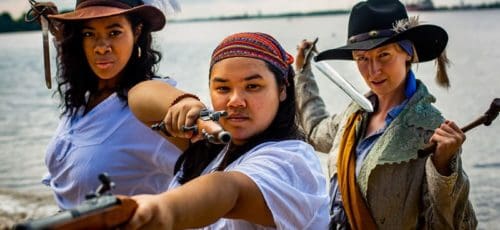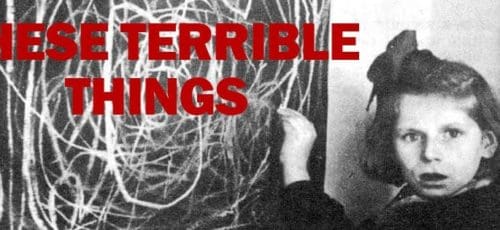Theater Artist Justin Jain Plays The Field
“Making my work fit me is like wearing a well-tailored suit,” says Justin Jain of his art. “If it doesn’t fit well, it’s my fault.”
Jain, a 30-year-old playwright, performer, and theater researcher, identifies the devised work of collaborative theater as the form that allows for the satisfying “well-tailored suit” self-expression he loves. In the eight years since he graduated from the University of the Arts in Philadelphia, Jain has worked steadily to branch out creatively. In contrast to the tradition of the playwright bringing his play to a director, who then masterminds the process, collaborative theater means everyone creates. All members are writers and performers and directors.
With collaborative pieces, Jain enjoys the egalitarian approach to the creative process. “There is a clear hierarchy in the traditional model—ultimately it’s the director’s vision. But in the collaborative world, especially in new work, everybody’s voice is equal. There’s a lot more social skill that you have to integrate into the process,” he explains.
But all that is not to say that the collaborative model is infallible. “One of the things that often gets glossed over in the collaborative process is attention to subtlety; that really fine-tuned acting work can sometimes get lost because you’re worried about the writing or you’re worried about the dance piece in the middle. Whereas in traditionally-modeled pieces, you have just one job as an actor—you can plot out everything down to the way you hold your coffee cup,” he says.
Though collaborative work has captivated Jain’s interest for several years, he maintains a connection to more traditionally-created shows as well. Today, Jain is heavily involved in both traditional and more avant-garde realms of the artistic community. Through acting in shows like Cyrano at The Arden Theater (final shows this weekend!), Jain still fulfills his role as a “conventional” actor. His more collaborative projects include working with his theater company, The Berserker Residents, which he helped to form in 2007, and other original works he creates.
“They fulfill different parts of my animal brain,” he explains.
Between cultivating his own theater company, acting in various local shows, and being a current Live Arts Brewery (LAB) fellow, Jain is a busy man. His work at LAB has helped integrate different aspects of his career. The position is research-based, allowing fellows to pose questions and use studio time to explore various areas of an artist’s interest. Jain is involved in three different projects. First, he seeks to explore how the identity of the gay American male is represented in society and art. Second, he is working to expand the Berserker Residents, developing sketch videos and cabaret sketches to showcase group talent. Third, he is working with Philadelphia Young Playwrights to mentor student writers and to set up monthly professional development workshops for others working with the youth.
The opportunity to do hands-on research at the LAB especially guides Jain’s interests; his exploration of American identity will evolve into a show. Working on original material is inspirational, he says, especially in the freedom it affords him.
“I can make my own rules because in the traditional theater world, I’m a minority, I get out there and I try to do work, I could get cast in Miss Saigon. But God forbid I’m in an Arthur Miller play,” he says with a laugh.
Creating his own work allows Jain to cut through the limits he may face when acting in more traditional roles. He also feels freer to tap into the things that inspire him most, like humor, which he brings to much of his work.
“I think humor is a very powerful and healthy way to make people understand the world a little better—you can take these polar opposite feelings people have and you can make a connection to them in an instant, and that connection makes a spark that can charge people in ways they don’t necessarily understand,” he explains.
Managing and mapping connections between two poles is nothing new to Jain. His personal life has evolved in a similarly polarized fashion. Born and raised in Florida, Jain spent his younger years in Catholic school. He was involved with the religious community, even working in a monastery as a teen; until high school, Jain believed he would possibly become a priest. But after high school, Jain decided to explore art school.
“I knew I wanted to get away from the heat in Florida, and to be near a metropolis. New York seemed like a little too much, so I settled on Philly,” he explains.
He came to Philadelphia to attend University of the Arts and hasn’t left since. Now, Jain exists between two poles—his religious family in Florida and his liberal bubble in Philadelphia. As with his art, Jain enjoys the contrast of his two homes. “I love finding ways to connect them,” he says. One such exploration is his interest in integrating his Catholic upbringing with his artistic expression by incorporating a look at Catholic identity into his research on American identity.
Jain’s path from his childhood Floridian home to the arts community of Philadelphia was influenced by a few key experiences he had growing up. His involvement with the arts began at the age of three, when he accompanied his mother to a dance class. Diagnosed with a rare heart disease as a toddler, Jain was advised to participate in a sport as treatment for his illness. He took up ballet, which spurred his life as an artist. The comfort he cultivated by being involved with dance led him to try out different performing arts.
“I had no idea what I was going to be in high school, and then I found the community theater and the drama club. I got into theater, and there was no turning back from there.” Jain cites his ballet teacher, Pirkko Lawler, and drama teacher, Rob Fritz, as important mentors who shaped his early artistic career.
While at University of the Arts, Jain’s interest was piqued by the process of collaborative art. Since he graduated, he has found that teaching is an apt medium for sharing his passion and paying forward the artistic mentorship he enjoyed as a student, particularly with high schoolers.
“I feel like I get teenagers in a way that some teachers are scared of. I love it all—they’re so passionate about everything that’s personal to them, and everyone is so heightened. [Teaching them] almost feels like a play sometimes,” he says.
In upcoming months, Jain will be as busy as ever. With the Berserkers, he is remounting two pieces, one in California and one in the Philadelphia area. Jain will also be Aladdin in an upcoming panto at People’s Light and Theatre Company.
Jain cites a few themes he is interested in exploring in the near future. Personally, he says he wants to look at Catholicism, which shaped so many of his early experiences, and its role in American identity. With the Berserkers, he says the group has been kicking around ideas of ghosts, ghost hunting, and fathers.
“[The process] always starts with touchstones, and they can be totally disparate. You ask yourself, how do you connect those things? Sometimes they fall away to the wayside, but if they make it to the final product . . .” Jain pauses. “Well, that’s, like, AWESOME.”
–Prarthana Jayaram





